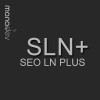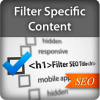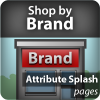SEO - Search Engine Optimization Settings
About SEO for Layered Navigation
SEO Schemas (MANAdev -> SEO Schemas)
Filter Specific SEO parameters (MANAdev -> Layered Navigation)
SEO URL Keys (MANAdev -> SEO URL Keys)
About SEO for Layered Navigation
HINT: Software from MANAdev provides tools to achieve various SEO goals. Different stores need different SEO strategies, what is good for small store, might be not so suitable for a large, there is no one recipe for all cases. We do suggest our vision which is based on best Google practices. However there is nothing better than good, unique and quality content be it CMS, category pages, filtered pages, product pages or simply images of products.
After installing, extension defaults are suitable for the most cases. But settings can be changed easily according to another vision.
We have noticed customers use two main strategies:
- Do not to index filtered pages at all, but rather accumulate all search ranking on category pages.
- Extend set of indexed store pages with SEO optimized filtered pages.
Our extensions allow implementing both strategies.
SEO Layered Navigation Plus extension by MANAdev provides:
- Very flexible URL structure - whether you prefer flat URL structure, like
domain.com/category-filter-optionor nested, deep directory structure like -domain.com/category/filter/optionor ... - all is achievable with our extensions, there are many settings for it. - A powerful tool for multilingual URL construction. For example German specific symbols can be replaced by Latin symbols or their combinations.
- A lot of Canonical URL settings.
- Redirect to real subcategory pages instead of simple filtering by category (preventing double content issue)
To be even more flexible and precisely control filtered page uniqueness, we offer also Filter Specific Content by MANAdev extension, which provide a variety of instruments, especially important for search engines, for every filtered page layer like:
- customizing page headings
- filter specific description
- page meta title (displayed in browser's tab caption)
- meta keywords and meta description
- different banners and more
For more details please check Filter Specific Content extensions page and manual
SEO Schemas
MANAdev -> SEO Schemas
SEO Schema is a collection of settings, which are currently acting in the store.
To open current SEO schemas, go to menu MANAdev -> SEO Schemas in Magento Admin Panel:
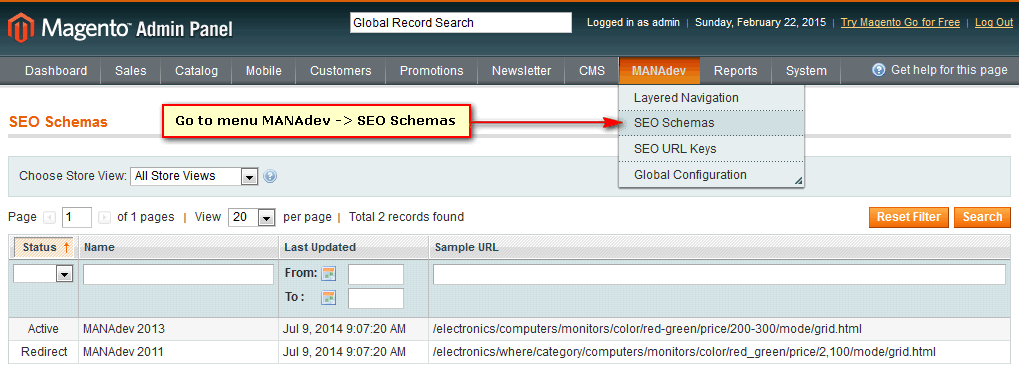
Here you will find a list of store seo schemas.
Only one schema can be
Activeat a time
Other schemas are Redirect schemas or Disabled schemas.
Active Schema
Active schema is a collection of settings, which are currently acting in the store.
If this store is not released and is not indexed yet, all active SEO schema parameters can be modified.
However, if store is live, running and indexed, parameters should be changed very carefully. If one of below listed parameters is intended to be changed, it should be done in newly created active schema, while current active schema will redirect to it:
- Query Separator
- Parameter Separator
- Value Separator
- Multiple Value Separator
- Price Separator
- Include Filter Names Before Values
- Use Attribute Labels Instead Of Attribute Codes
- Use Range Bounds in Price Filters
- Special Symbols in URL
- Toolbar URL Keys
So typically steps for such changes:
- Copy current
Activeschema - pressDuplicatebutton. - Make changes in it.
- Change status of new duplicated schema to
Active - Old schema will get
Redirectstatus automatically.
Disabled Schema
Disabled is inactive schema. If necessary, you can always change Redirect status to Disabled, although it is not recommended.
While new schema is not finished, keep it Disabled, and after you are done, change it to Active.
Redirect Schemas
Redirect schemas are ones, which had been used some time ago, however, later on, new schema with different settings was created. To not loose already gained search engine traffic and for customers usability old type URLs by default are redirecting to new URL structure and so on.
For example, store URL structure is separated with slashes:
www.store.com/dresses/color-red-blue/size-xl-xxl/brand-victorias-secret
And you want it to be separated with dashes:
www.store.com/dresses/color-red-blue-size-xl-xxl-brand-victoria-secret
If you just change parameters, this URL will be valid and page will be accessible. However, if old page was indexed by Google, or customer had bookmarked it, those references will lead to 404 'Page not found' page, you might loose already achieved page ranking. To prevent it, new parameters should be set in new schema, while old schema should be redirected.
This way old link will be redirected to the page with new URL.
In most cases, there is no sense to modify Redirect schema and it is not recommended.
MANADEV 2011 Schema
By default MANADEV 2011 SEO redirect schema is created for those, who used old extension version. Until 2013 SEO Layered Navigation Plus extension by MANAdev filter page URL was:
/electronics/where/category/computers/monitors/color/red_green/price/2,100/mode/grid.html
In 2013, SEO Layered Navigation Plus extension by MANAdev was improved a lot and was changed to the very flexible tool for constructing URL:
- where part was eliminated
- any desired word instead of category
- and many other features.
SEO Schema Parameters
MANAdev -> SEO Schemas -> [click on schema]
Now let's review SEO schema parameters, available in
SEO Layered Navigation Plus extension by MANAdev
If you are in Magento Admin Panel go to menu MANAdev-> SEO Schemas. To start editing schema, just click anywhere on schema record:
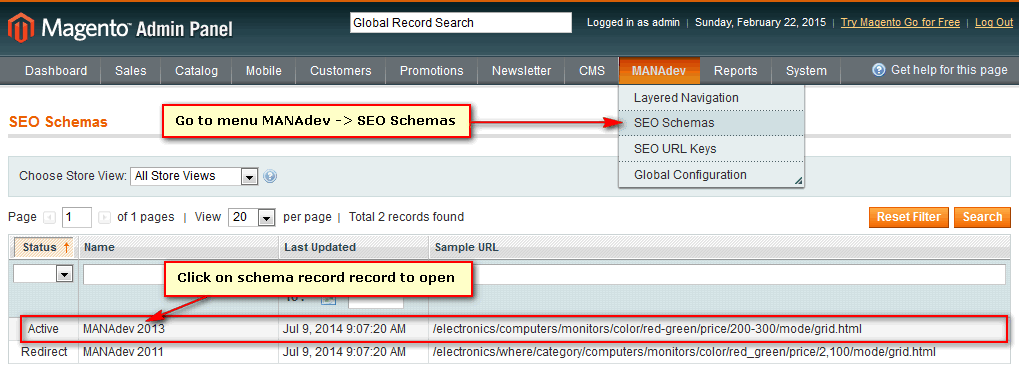
After selected schema is opened, you will see information grouped into four tabs:
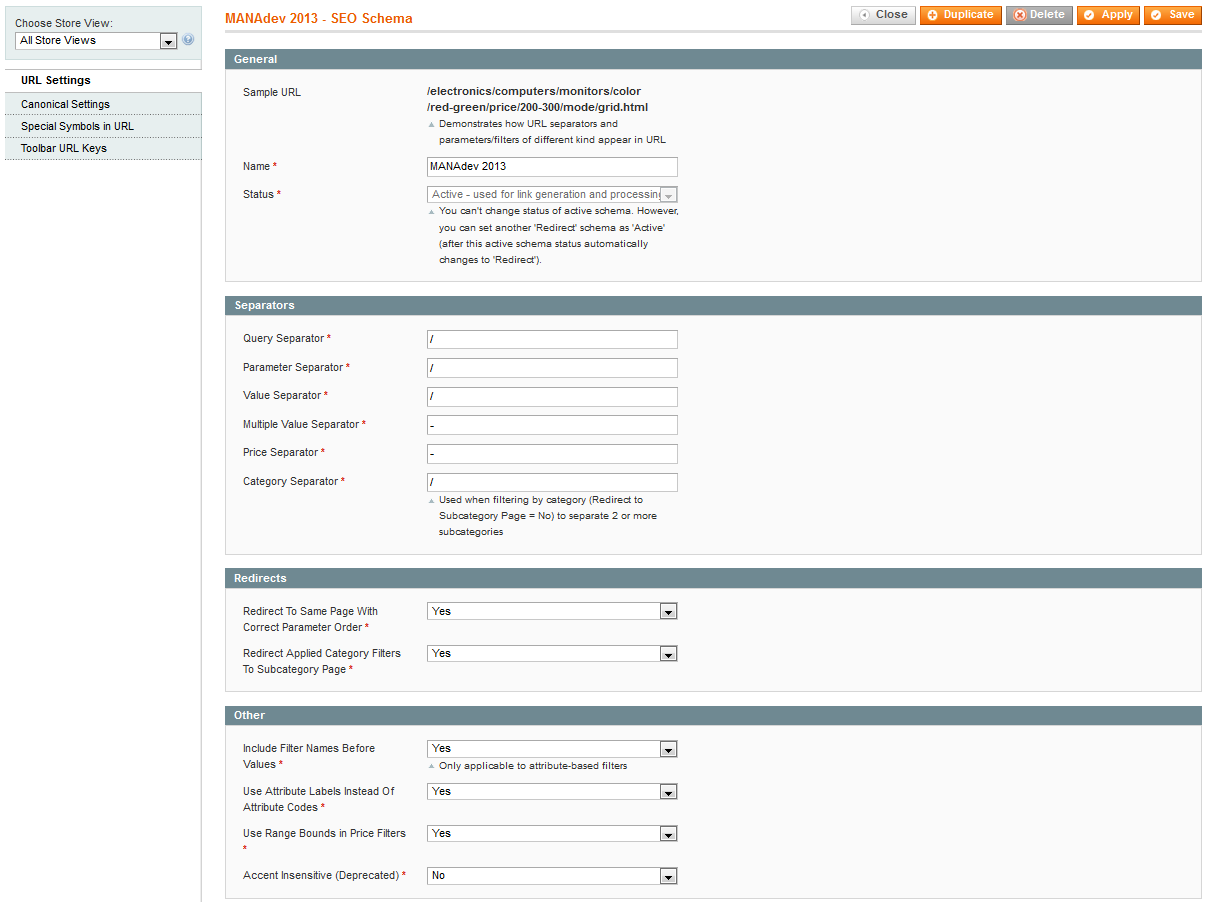
URL Settings
MANAdev -> SEO Schemas -> [click on schema] -> URL Settings
General section:
Sample URLpresents typical URL structure example, which is currently acting in your store. While parameters are changed, you can see live example of URL, which will be supported after schema is saved. This is visual facilitation of setting up parameters in order to achieve your goal.Nameis any kind of a name you like. It is used just for you to remember, why schema was created and to distinguish it between others.Status- schema status. SEO schema can beActive,RedirectorDisabled. This field will be disabled forActiveschema. You can set anotherRedirectschema asActive(after this active schema status automatically changes to 'Redirect').Disabledis inactive schema. If necessary, you can always changeRedirectstatus toDisabled, although it is not recommended. While new schema is not finished, keep it disabled, and after you are done, change it toActive.
Separators section:
Symbols, which are used for filtered page URL generation, are listed here.
Useful notes:
- You cannot use special URL symbols like "&", "?", "=" .
- Separator can have more than one symbol
Separators can help to give the impression of catalog structure by using "/", for example, or flat structure with "-" for every SEO expert taste. It is your right to choose.
Query Separatorseparate category from filter.Parameter Separatorseparate filters from each other.Value Separatoris used between filter name and filter values.Multiple Value Separator- between filter options.Price Separatoris used between price min and max values.Category Separatoris used between categories, but only in case when category are used as filters (not recommended because of double content issue) and redirecting to categories is disabled.
Redirects section:
Redirect To Same Page With Correct Parameter Order.Yesis recommended in order to prevent double content issue. Double content issue appears when several different URLs show exactly the same result. For example, customer click on "Red", then on "Blue" color filter and getcolor-red-bluein URL. If customer selects the colors in opposite order, URL iscolor-blue-red. But product lists for those two different filters are the same. Therefore, ifYesis selected, options will be listed in one and the same order in spite of click order.Filter option order (red or blue goes first in url), as well as other filter specific settings can be set in Search Engine Optimization section of particular (in our example
Colorfilter. More in details in Filter specific SEO parameters section.Redirect Applied Category Filters To Subcategory Page.Yesis recommended. By default Magento category filter just do the filtering of the same page. Here is very thin and hardly understandable by many people difference between category page, filtered by subcategory, and subcategory page itself.For example, if in
Electronicscategory we are filtering byComputers, we in fact are filteringElectronicspage byComputersfilter, which is not the same asComputerssubcategory page. Although, those two pages have the same set of products, we are facing Double content issue problem when two different URLs shows the same content.So, very advanced feature of SEO Layered Navigation Plus extension by MANAdev is that, instead of applying filter, user can be redirected to real subcategory page, preserving all other applied filters and preventing Double content issue.
Other section:
Include Filter Names Before Values.If
Yesis set you will get URL likedomain.com/electronics-color-red. It is recommended to set toYesbecause of less probability of URL key conflict.If
Nois set you will get URL likedomain.com/electronics-red. ChooseNo, if you really understand what you are doing and you are sure that options are unique in whole store view.Exception: For
Pricetype attributes filter name cannot be removed from URL.Exception:
Categoryfilter name, if it is used as filter (instead of redirecting to subcategory page) also cannot be removed from URL.Please read about URL key conflict before using this option.
If there are no duplicated attribute options, by choosing
No, you can achieve shorter and more elegant URLs.Use Attribute Labels Instead Of Attribute Codes.Yesis recommended for better URL readability and attribute translation support. It is more customer friendly, but in special cases, you can useNo.Use Range Bounds in Price Filters. In most cases should be set toYes, which allows to see min and max price range bounds in URL.Nois used only for redirect schemas and used for compatibility with old extension version.Accent Insensitive (Deprecated). Should be always set toNo. This setting will be removed in a future.
Canonical Settings
MANAdev -> SEO Schemas -> [click on schema] -> Canonical Settings
Canonical URL section:
You can find a lot of information about canonical links in Google. For example, Specify your canonical
Canonical Link Meta Tag on Category Pages.Yesis recommended. It will put canonical meta tag on category pages. You can remove canonical meta tag by sayingNo.Canonical Link Meta Tag on Quick Search Page.Yesis recommended. It will put canonical meta tag on quick search pages.Canonical Link Meta Tag on CMS Pages.Yesis recommended. It will put canonical meta tag on CMS pages, where layered navigation is used.Canonical URL Contains All Applied Filters. It's up to you, what to choose.Yesis recommended when you are interested in expanding your store with genuine filtered product collection pages. Canonical URL will point to the same filtered pages with applied filters.Nois recommended when you are interested in only category pages - canonical URL will point to main category page.Canonical URL Points to the Page with All Items. You can refer to Google best practice View-all in search results, to make your choice, while our recommendation isYesif category page contains reasonable amount of products. In this case canonical URL will point to view-all page, where all filter results are listed in one page without pagination. Otherwise, search results will be divided into page and first page will be used as canonical URL.Canonical URL Contains Page Parameter. Includes Page 2 on second page, Page 3 on 3rd page and so on into canonical URL.
rel=prev and rel=next Paging Hints section:
rel=prev and rel=next URLs on Paginated Product List Pages. If set toYes, category pages will contain canonical meta tag pointing to next and previous pages.Remove Canonical URL on Second and Further Pages. Specifies whether canonical meta tag should be removed from page when product list pager is used. Possible values:Never- leave canonical meta tag rendered as specified in Canonical URL section.On non-filtered pages only- canonical meta tag is removed from page if a) pager is used; b) no filter is applied; c) no product list toolbar parameter is applied (like grid/list mode or sorting)On all pages except having toolbar parameters- canonical meta tag is removed from page if a) pager is used; b) no product list toolbar parameter is applied (like grid/list mode or sorting)
Special Symbols in URL
MANAdev -> SEO Schemas -> [click on schema] -> Special Symbols in URL
There are some restrictions on symbols, that is used in URL, some of specific symbols are reserved for other purposes (";" , "/" , "?" , ":" , "@" , "&" , "=" , "+" , "$" , ","), some are incorrectly interpreted by search engines ("_").
This set of symbols will be used to replace one symbol with its substitutions. If you want to remove specific symbol from URL at all, you can leave Substitute field empty. Also, you can substitute one symbol to several characters.
Another useful application of this feature is to convert national characters to Latin in URL. For example, you can easily substitute German symbol "ä" (a-umlaut) with "ae" Another example when you need replace all local characters with Latin letters in URL. You can enter whole alphabet
For every desired symbol conversion you need to create a pair of symbol and its substitution. To do this, press Add button and fill up symbol and substitution fields
![Special symbols in URL] Special symbols in URL](https://www.manadev.com/media/wysiwyg/user-guides/layered-navigation/seo-special-symbols-in-url.png)
Toolbar URL Keys
MANAdev -> SEO Schemas -> [click on schema] -> Toolbar URL Keys
Here you can create substitutions for URL parameters, to get more readable URL for human beings. Magento generates URL parameters from product list toolbar, sorting and pagination, while you want to have them more understandable.. For example, you can see p=2 in non-SEO URL, but extension can convert it to page-2.
![Toolbar URL keys] Toolbar URL keys](https://www.manadev.com/media/wysiwyg/user-guides/layered-navigation/seo-toolbar-url-keys.png)
Filter Specific SEO parameters
MANAdev -> Layered Navigation
Filter options order in URL, as well as other filter specific SEO settings can be set in Search Engine Optimization section of particular filter. Go to menu MANAdev -> Layered Navigation and click on filter:
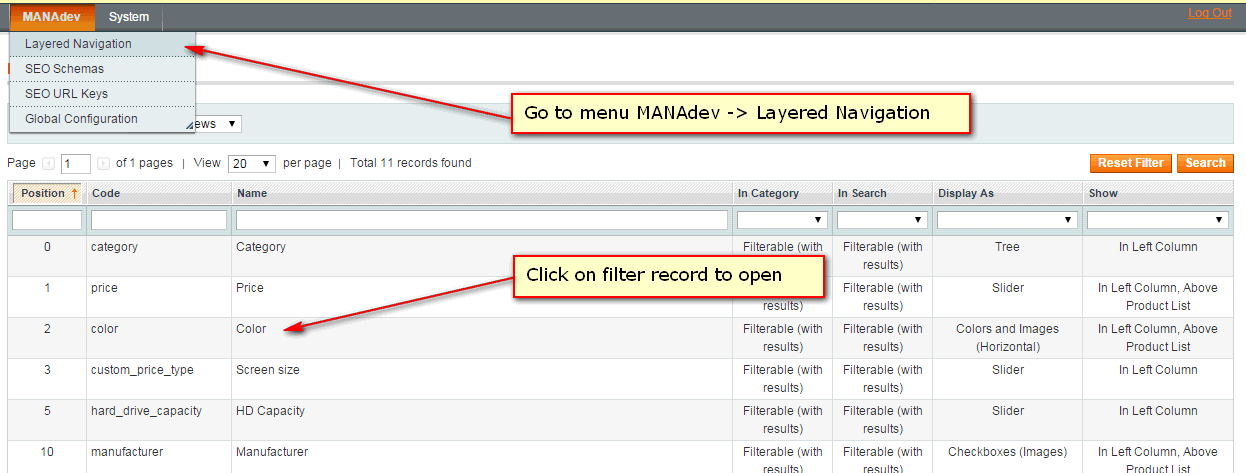
In General tab, find Search Engine Optimization section. All here listed settings are overriding correspondent global SEO schema settings for selected filter. Below section settings are reviewed:
Include Filter Name In URL. For example, for color filter you can skip wordcolorand URL will contain only filter value, let's sayblue. It helps to have more elegant URL structure, but you should be very careful with possible URL Key conflicts
Hint: URL key should be unique for every option in filter scope when attribute name is used in url, or globally for whole store view, if attribute name is not included to url.
Position in URLis relative filter position in URL. For example, if forcolorfilter you will set it to 10, while forbrandyou set it to 20, in URLcolorwill always be placed beforebrand. The same is for filter options. All option position can be reviewed in attribute management (standard Magento admin menuCatalog -> Attributes -> Manage AttributesInclude Applied Filter In Canonical URL. This is used to override global SEO schema setting for specific filter. You can choose:- As specified in current SEO schema settings
- Always
- Never
SEO URL Keys
MANAdev -> SEO URL Keys
This tool is used to monitor URL keys, find and solve URL key conflicts.
Here you can quickly find and overview store URLs. Also here you can change URL key manually if needed.
In Magento Admin Panel go to menu MANAdev -> SEO URL Keys:

We recommend filtering list by Status, Schema and Store View first. Select Active schema status and press Search
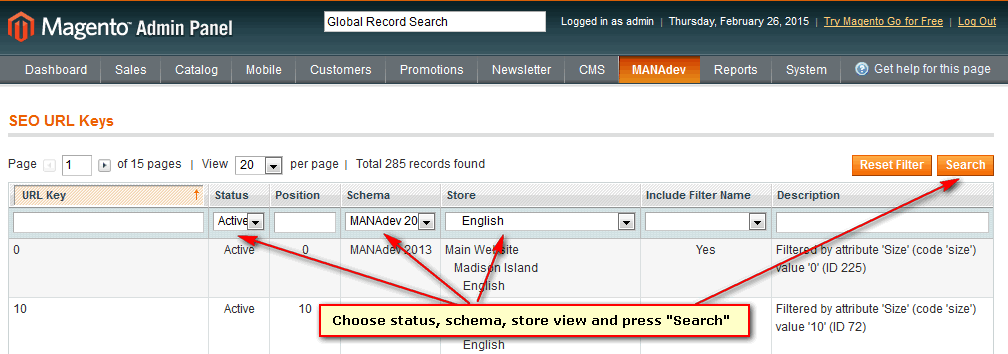
If you know, that there is URL key conflict, filter the list by searching on problematic key.
For example, let's find "brand" key. Write "brand" in URL Key and press Search again, this will narrow the list of URL keys.

This way you get the list of pages where "brand" url key is used on particular store view.
Select the record, you want to modify. This will open URL key window, where you can find general information about URL, which cannot be edited, as well as the field for manual overriding of URL key value.
Descriptionwill tell you in human language, how this URL key is created, which attribute or category is the basis for this key and other important information about active rules.Status- current status of SEO schemaPosition- relative position in URLSchema- SEO schema nameStore- store nameDefault URL key- generated URL key, which is active when no manual overriding is applied.Manual URL keyused to replace default URL key. For example, to solve URL key conflictActually Used URL Keycurrently acting URL key.
If you want mark URL key to be used instead of current brand - type mark in Manual URL key and press Save button.
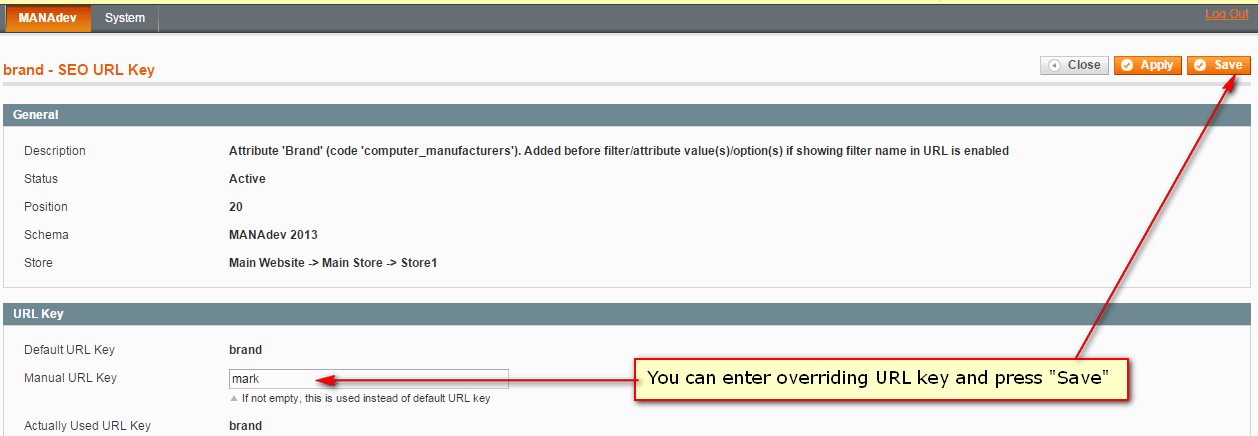
URL Key Conflict
URL key conflict happens when one and the same URL is used for different purposes.
How to recognize SEO URL key conflict? After you had applied the filter, you saw "Please wait" message, but nothing was changed in the page, after message animation had been finished. Then, if you press F5 in order to refresh the page, you will get 404 'Page not found' page. This is first sign, indicating, that URL key conflict exists for this filter or option.
Example 1
You have attribute with code shoes_brand and attribute with code apparel_brand. You name both simply Brand.
By default URL key for attribute = attribute name (only lowercase).
So in this example when shoes_brand filter is applied URL is like domain.com/category/brand/option
And when apparel_brand filter is applied URL is like domain.com/category/brand/option
When Magento reads URL and finds brand in it, it doesn't know which of 2 filters is applied - shoes_brand or apparel_brand. In such situation system returns 404 Page not found page.
Example 2
You have attribute 'Material' with options Cotton, Polyester, Cotton Polyester
By default spaces in URL are replaces with - sign. And also Multiple Value Separator in SEO Schema is - sign.
So when options Cotton and Polyester are applied URL is like domain.com/category/material/cotton-polyester.
And when simply option Cotton Polyester is applied you get the same URL domain.com/category/material/cotton-polyester.
Again, when Magento reads URL and finds cotton-polyester in it, it doesn't know which filter is applied, it might apply 2 options Cotton and Polyester instead of one Cotton Polyester.
Solving URL Key Conflict
Simplest way to avoid URL key conflict is to follow these best practices:
Keep attribute names unique per store view.
Keep option names unique inside the same attribute.
NOTE: It is not recommended to have different attributes of the same meaning for every attribute set, like 10 colors for every attribute set or 10 brands. Filter options in Layered Navigation depend on products in category (for better understanding how Layered Navigation works in Magento please read What is Layered Navigation in Magento topic, so you will not get shoe brands in apparel category and vice versa. Quick search page is also more elegant with a single attribute for color or brand, allowing to filter products with one color filter instead of 10 color filters.
If you really need more than one attribute with the same name in your store, make URL keys unique manually in MANAdev -> SEO URL Keys. Alternatively, consider using attribute code instead of attribute labels option in active SEO schema.
For situation demonstrated in example 2:
- consider changing
Multiple Value Separatorin active SEO schema to+sign or some other; - alternatively, consider changing
space symbol with+sign or some other inSpecial Symbols in URLtab in active SEO schema (by default is is replaced with-sign).

